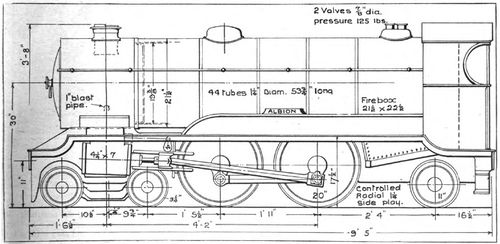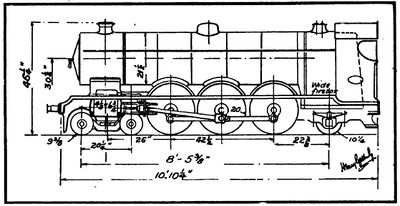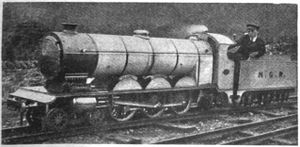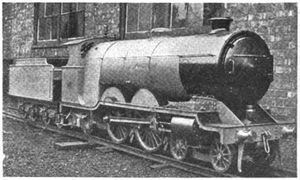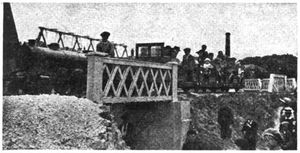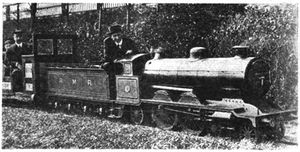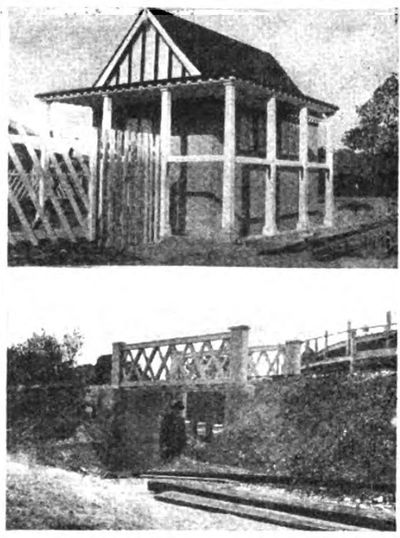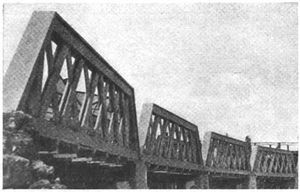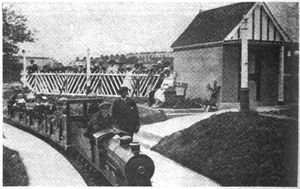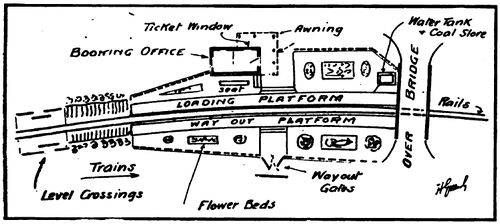Miniature Railway Development in Great Britain
Assoc. Inst. Loco. Engineers, England
From "Everyday Engineering Magazine", October 1920
Some Interesting Details of Narrow Gauge Railways Used for Pleasure and Profit and Descriptions of Typical Locomotives Employed on Them
The past year has seen a considerable development in 15 inch gauge Miniature Railway work in Great Britain. The only public railway, i.e., one which runs to time-table all the year round and that carries goods and G.P.O. mails, is that at Eskdale in the lake district of Cumberland, and to cope with increased traffic a new Pacific engine, made from the writer's designs has just been completed and put into service. This engine weighs in working order 5,000 pounds, of which 2,500 pounds is carried on the coupled wheels. The cylinders are 4-1/8 inch bore and 6-3/4 inch stroke and have the valve chests on top. The reversing gear is standard Stephenson's link motion operating from the inside to the outside through a rocking shaft. The driving wheels are 20 inch diameter, with tires 1-7/8 inch wide spaced 14 inches apart. The axles are 2-1/16 inch diameter, the driving axle having the eccentrics forged on solid with the shaft. The boiler is 20 inch diameter at the firebox end and has a barrel 5 feet 11-14 inches long. The heating surface of the generator is as follows:
- Tube - 11,672.7 square inches
- Firebox - 1,412.6 square inches
- Total - 13,085.3 square inches
The boiler pressure is 126 pounds per square inch which pressure is easily maintained with the heaviest loads. The Eskdale line is just over seven miles long and rises from the coast station at Ravenglass about 180 feet. This represents an average gradient of 1 in 207 (1/2%) but in fact, due to the undulating surface, 1 in 80 is the ruling grade with substatial sections of 1 in 34, 1 in 42 and 1 in 46.
The line at Eskdale is an old one and was originally laid to a gauge of 33 inches but in 194, after having been closed for over a year was leased to the "Narrow Gauge Railways Ltd." and converted to 15 inch gauge. On one train, the 11:20, a non-stop train from Ravenglass, which does the seven miles in 40 minutes, a slip carriage is used. On the Rhyl Miniature Railway, a pleasure line at that well known seaside resort, in Northwales, the first of a new series of Atlantic Engines has just been completed. In the main the details are similar to that of the "Eskdale" Pacific Engine, but the cylinders have been increased to 4-14 inch diameter by 7 inch stroke and the trailing wheel is carried by inside bearings. These axle-boxes are of the radial type arranged in quite a simple and novel manner.
The latest railway to be installed is that at Margate, in Kent, one of London's popular seaside towns. Here the line is designed for the delectation of the younger visitors. It is a quarter of a mile in length and laid in the form of an irregular circle. The surface of the site was such that most of the line is either in cuttings or an embankment. This feature enabled the writer to introduce interesting effects. At the highest point, the line traverses a five-span viaduct 86 feet long. Each of the spans has a Warren type truss, the outer members of which are 17 feet 4 inches long and the inner ones 16 feet 4 inches long to provide for the 100 foot radius curve to which this part of the line is laid. Four of the spans cross an artificial pond while the fifth is laid over a roadway leading to the center of the park. Beyond the viaduct another under-line bridge is erected. The truss for this bridge is also of wood, 12 feet long over all the rests on concrete block abutements. The piers for the long viaduct were constructed with concrete slabs of the British standard 18 by 9 inch size. These slabs were 3 inches thick, and the boxes they formed were filled with coarse concrete.
There are two over-line foot-bridges, and, as the time available for the construction of the line was very limited, these were made out of steel bars and sections, with concrete floors. The thinness of these floors (4 inches) was of considerable help in keeping down the gradients at the approaches.
The station has concrete platforms and is laid out with grass banks and flower beds. The station booking office was built with hollow concrete blocks 4-1/2 inches thick, a material which is cheaper than rough wood in Europe at the present time; the roof, however, is of wood and is colored with a preservative to represent old tiles.
The Sunk Station proved quite a success. The turfed banks sloping down to platforms gives it a spacious appearance and the arrangment of the booking office, doors and gates make the station very workable with a minimum staff. The over-bridge at the end of the platform lends interest to the juvenile passengers who wave "good-bye" to their Mammas as the train passes under the archway.
At the entering end of the staiton, a cutting was formed surmounted by a privet-hedge. At the end of this a level crossing for foot passengers was arranged to protest against children blundering across the track. Zigzag barriers 3 foot 6 inches high were erected to break any such rush. The water tank for the locomotive covers the coal store. The rails are standard flat-bottom section and are coach screwed to 7 by 4 inch sleepers, square washers intervening between the head of the screw and the rails.
The locomotive at present used at Margate is one of the "Atlantic" type of the writer's 1904 design, built in 1909. This engine weighs 3,400 pounds and has cylinders 3-3/8 inch bore by 6 inch stroke. Direct link motion is fitted, the valve chests being inside the frames. The coupled wheels are 18 inch diameter and have an adhesive weight of 1,200 pounds resting on them. This engine has something like 50,000 miles to its credit, but is still in good working order. The new engine with doulbe the tractive effort, i.e. 700 pounds instead of 300 pounds, promised from the Rhyl batch will, however, take over the bulk of the work, the old engine, "Pricess Edward of Wales", being classed as a spare.
The capacity of the Margate line is at present 750 passengers per hour, 24-1/2 trains per hour, (including loading and unloading) which is a measure of the traffic of an average busy day. With the new engine this could increased to over 1,200 per hour.
